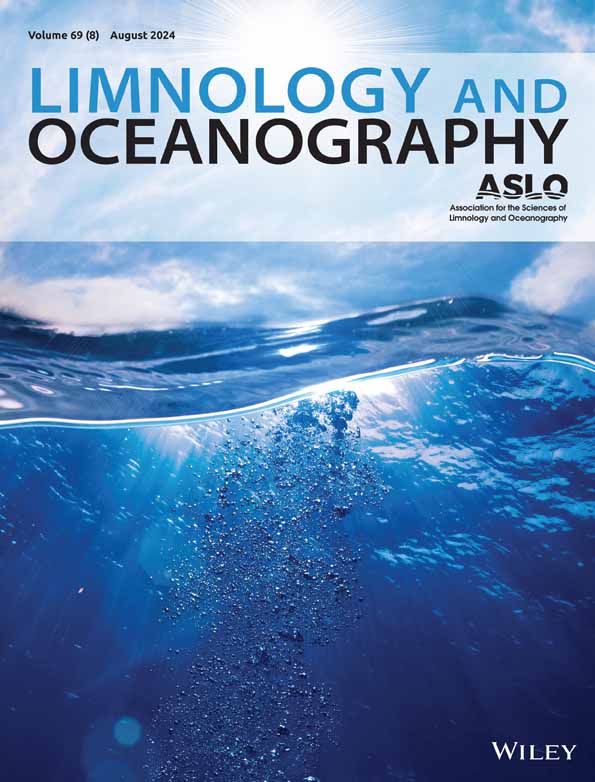西界大陆架生态系统模式浮游植物类群的铁生理与代谢
IF 3.7
1区 地球科学
Q1 LIMNOLOGY
引用次数: 0
摘要
大陆架生态系统支持多种浮游植物群落,为全球初级生产力做出贡献。铁元素是控制海洋浮游植物生长的重要微量元素,但其对西界大陆架生态系统浮游植物生理生态的影响尚不清楚。为了研究陆架区域之间的铁生理,我们在南大西洋湾相对富铁的内陆架和低铁的外陆架上采集了具有代表性的硅藻(圆柱藻)和球石藻(大洋藻和赫克斯莱藻),在高铁和低铁条件下生长。研究了特定生长速率、光生理和基因表达模式。硅藻采用了能够成功跨越大陆架区域的策略,包括高的最大增长率。它们的高光保护能力可能有助于在铁限制下保持光系统II的最大潜在量子效率(Fv/Fm)和短的Qa再氧化时间(τQa)。相反,球石藻分离物表现出适合于它们起源的陆架区域条件的代谢策略。在低铁培养基中,内陆架洋藻的生长下降了71%,而外陆架赫胥黎藻的生长仅下降了35%,表明其对铁限制的敏感性较低。本文报道的生理和代谢模式可能有助于解释观测到的西部边界大陆架生态系统浮游植物群落组成和水华演替模式。本文章由计算机程序翻译,如有差异,请以英文原文为准。
Iron physiology and metabolism of model phytoplankton taxa in a western boundary continental shelf ecosystem
Continental shelf ecosystems support diverse phytoplankton communities that contribute to global primary productivity. Iron is an important micronutrient controlling the growth of marine phytoplankton, but its role in influencing phytoplankton ecophysiology in western boundary continental shelf ecosystems is understudied. To examine iron physiology between shelf regions, representative diatoms (Cylindrotheca closterium ) and coccolithophores (Gephyrocapsa oceanica and Gephyrocapsa huxleyi ) collected from the relatively iron‐rich inner shelf and lower iron outer shelf of the South Atlantic Bight were grown under high and low iron conditions. The specific growth rates, photophysiology, and gene expression patterns were investigated. The diatoms employed strategies that enable success across shelf zones, including high maximum growth rates. Their high photoprotective capacity likely contributed to maintaining maximum potential quantum efficiency of photosystem II (F v /F m ) and short Q a reoxidation times (τQ a ) under iron limitation. In contrast, the coccolithophore isolates demonstrated metabolic strategies suited to conditions of the shelf region from which they originated. The growth of the inner‐shelf G. oceanica was decreased by 71% in low iron media, while that of outer‐shelf G. huxleyi was decreased by only 35%, indicating a lower sensitivity to iron limitation. The physiological and metabolic patterns reported here may help explain observed phytoplankton community composition and bloom succession patterns in western boundary continental shelf ecosystems.
求助全文
通过发布文献求助,成功后即可免费获取论文全文。
去求助
来源期刊

Limnology and Oceanography
地学-海洋学
CiteScore
8.80
自引率
6.70%
发文量
254
审稿时长
3 months
期刊介绍:
Limnology and Oceanography (L&O; print ISSN 0024-3590, online ISSN 1939-5590) publishes original articles, including scholarly reviews, about all aspects of limnology and oceanography. The journal''s unifying theme is the understanding of aquatic systems. Submissions are judged on the originality of their data, interpretations, and ideas, and on the degree to which they can be generalized beyond the particular aquatic system examined. Laboratory and modeling studies must demonstrate relevance to field environments; typically this means that they are bolstered by substantial "real-world" data. Few purely theoretical or purely empirical papers are accepted for review.
 求助内容:
求助内容: 应助结果提醒方式:
应助结果提醒方式:


